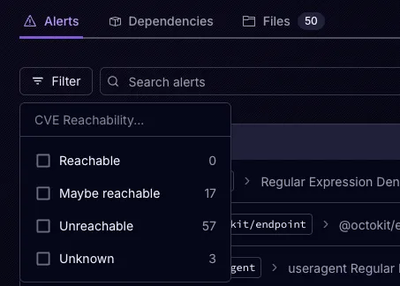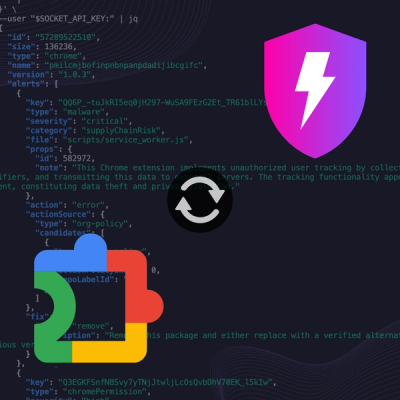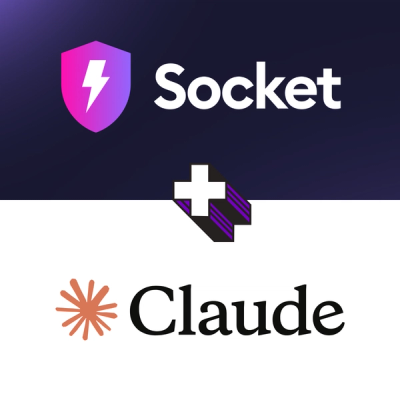
Product
Announcing Precomputed Reachability Analysis in Socket
Socket’s precomputed reachability slashes false positives by flagging up to 80% of vulnerabilities as irrelevant, with no setup and instant results.
Unofficial TypeScript SDK for Gladia - State-of-the-art Speech to Text API
npm install gladia
# or
yarn add gladia
import { GladiaClient } from 'gladia';
const client = new GladiaClient({
apiKey: process.env.GLADIA_API_KEY || 'your-api-key',
language: 'en',
diarization: true,
});
// Transcribe a YouTube video
const result = await client.transcribeVideo(
'https://www.youtube.com/watch?v=DYyY8Nh3TQE'
);
// Print the full transcription
console.log(result.result.transcription.full_transcript);
// Print speaker information
if (result.result.speakers && result.result.speakers.length > 0) {
result.result.speakers.forEach(speaker => {
console.log(
`Speaker ${speaker.label}: ${speaker.confidence * 100}% confidence`
);
});
}
// Print segments with timing
result.result.transcription.segments.forEach(segment => {
console.log(`[${segment.start}s - ${segment.end}s] ${segment.text}`);
});
interface GladiaConfig {
apiKey: string; // Required: Your Gladia API key
baseUrl?: string; // Optional: Custom API base URL (defaults to https://api.gladia.io/v2)
language?: string; // Optional: Default language for transcription
diarization?: boolean; // Optional: Enable speaker diarization
diarizationConfig?: {
// Optional: Diarization configuration
number_of_speakers?: number;
min_speakers?: number;
max_speakers?: number;
};
}
transcribeAudio(
audioUrl: string,
options?: TranscriptionOptions
): Promise<TranscriptionResult>
transcribeVideo(
videoUrl: string,
options?: TranscriptionOptions
): Promise<TranscriptionResult>
transcribeFile(
file: File | Blob,
options?: TranscriptionOptions
): Promise<TranscriptionResult>
getTranscription(
id: string
): Promise<TranscriptionResult>
deleteTranscription(
id: string
): Promise<void>
createRealTimeTranscription(
options?: RealTimeTranscriptionOptions
): WebSocket & {
sendAudio: (audioChunk: ArrayBuffer | Blob) => void;
stopRecording: () => void;
}
translateAudio(
audioUrl: string,
targetLanguages: string[] | string,
options?: Omit<TranscriptionOptions, 'translation'>
): Promise<TranscriptionResult>
summarizeAudio(
audioUrl: string,
options?: Omit<TranscriptionOptions, 'summarization'>
): Promise<TranscriptionResult>
analyzeSentiment(
audioUrl: string,
options?: Omit<TranscriptionOptions, 'sentiment_analysis'>
): Promise<TranscriptionResult>
detectEntities(
audioUrl: string,
options?: Omit<TranscriptionOptions, 'named_entity_recognition'>
): Promise<TranscriptionResult>
moderateContent(
audioUrl: string,
options?: Omit<TranscriptionOptions, 'content_moderation'>
): Promise<TranscriptionResult>
generateChapters(
audioUrl: string,
options?: Omit<TranscriptionOptions, 'chapterization'>
): Promise<TranscriptionResult>
The SDK follows the official Gladia API v2 response structure:
interface TranscriptionResult {
id: string;
status: 'created' | 'processing' | 'done' | 'error';
result?: {
transcription: {
full_transcript: string;
segments: Segment[];
};
speakers?: Speaker[];
summary?: {
text: string;
};
sentiment?: {
score: number;
label: string;
};
entities?: Array<{
text: string;
type: string;
start: number;
end: number;
}>;
moderation?: {
categories: Array<{
name: string;
confidence: number;
}>;
};
chapters?: Array<{
title: string;
start: number;
end: number;
summary: string;
}>;
subtitles?: {
srt?: string;
vtt?: string;
};
translations?: Record<string, string>;
};
audio?: {
duration: number;
language: string;
};
error?: {
message: string;
code: string;
};
}
import { GladiaClient } from 'gladia';
// Initialize client
const client = new GladiaClient({
apiKey: process.env.GLADIA_API_KEY,
language: 'en',
});
// Transcribe a YouTube video
const result = await client.transcribeVideo(
'https://www.youtube.com/watch?v=VIDEO_ID'
);
// Check if transcription is complete
if (result.status === 'done' && result.result?.transcription) {
console.log(result.result.transcription.full_transcript);
}
import { GladiaClient } from 'gladia';
// Initialize client
const client = new GladiaClient({
apiKey: process.env.GLADIA_API_KEY,
});
// Create WebSocket for real-time transcription
const socket = client.createRealTimeTranscription({
language: 'en',
toggle_diarization: true,
toggle_interim_results: true,
});
// Handle incoming messages
socket.onmessage = event => {
const data = JSON.parse(event.data);
if (data.type === 'transcript' && data.is_final) {
console.log(`Transcript: ${data.text}`);
}
};
// Start recording after connection is established
socket.onopen = () => {
// For example purposes - assuming we have audio data chunks
// In a real app, you would get these from a microphone
const audioChunk = new Uint8Array([
/* audio data */
]);
socket.sendAudio(audioChunk.buffer);
// Later when done recording
socket.stopRecording();
};
// Close connection when done
socket.onclose = () => {
console.log('Transcription session ended');
};
import { GladiaClient } from 'gladia';
// Initialize client
const client = new GladiaClient({
apiKey: process.env.GLADIA_API_KEY,
});
// Translation
const translation = await client.translateAudio(
'https://example.com/audio.mp3',
['es', 'fr', 'de']
);
// Summarization
const summary = await client.summarizeAudio('https://example.com/audio.mp3');
console.log(summary.result?.summary?.text);
// Sentiment Analysis
const sentiment = await client.analyzeSentiment(
'https://example.com/audio.mp3'
);
console.log(sentiment.result?.sentiment?.label);
// Entity Recognition
const entities = await client.detectEntities('https://example.com/audio.mp3');
entities.result?.entities?.forEach(entity => {
console.log(`${entity.text} (${entity.type})`);
});
// Content Moderation
const moderation = await client.moderateContent(
'https://example.com/audio.mp3'
);
// Chapter Generation
const chapters = await client.generateChapters('https://example.com/audio.mp3');
chapters.result?.chapters?.forEach(chapter => {
console.log(`${chapter.title} (${chapter.start}s - ${chapter.end}s)`);
console.log(chapter.summary);
});
The SDK uses a custom GladiaError class for error handling:
try {
const result = await client.transcribeAudio('https://example.com/audio.mp3');
} catch (error) {
if (error instanceof GladiaError) {
console.error(`Error ${error.statusCode}: ${error.message}`);
// Handle specific error cases
if (error.statusCode === 401) {
console.error('Invalid API key');
} else if (error.statusCode === 429) {
console.error('Rate limit exceeded');
}
}
}
Contributions are welcome! Please feel free to submit a Pull Request.
git checkout -b feature/amazing-feature)git commit -m 'Add some amazing feature')git push origin feature/amazing-feature)MIT
If you encounter any issues or have questions, please file an issue on the GitHub repository.
FAQs
Official TypeScript SDK for Gladia - State-of-the-art Speech to Text API
The npm package gladia receives a total of 2 weekly downloads. As such, gladia popularity was classified as not popular.
We found that gladia demonstrated a healthy version release cadence and project activity because the last version was released less than a year ago. It has 1 open source maintainer collaborating on the project.
Did you know?

Socket for GitHub automatically highlights issues in each pull request and monitors the health of all your open source dependencies. Discover the contents of your packages and block harmful activity before you install or update your dependencies.

Product
Socket’s precomputed reachability slashes false positives by flagging up to 80% of vulnerabilities as irrelevant, with no setup and instant results.

Product
Socket is launching experimental protection for Chrome extensions, scanning for malware and risky permissions to prevent silent supply chain attacks.

Product
Add secure dependency scanning to Claude Desktop with Socket MCP, a one-click extension that keeps your coding conversations safe from malicious packages.